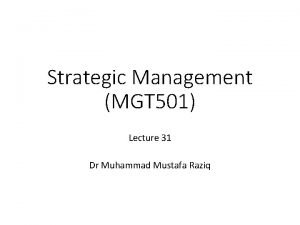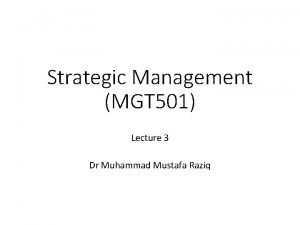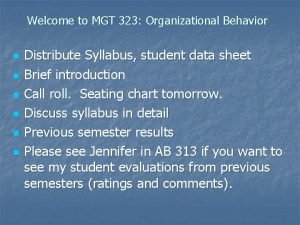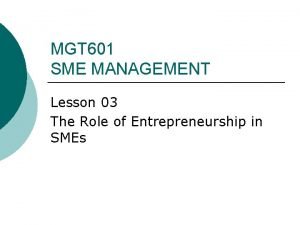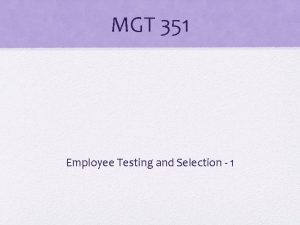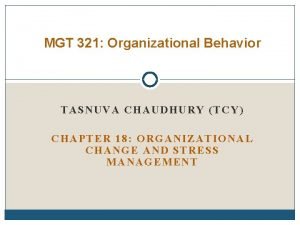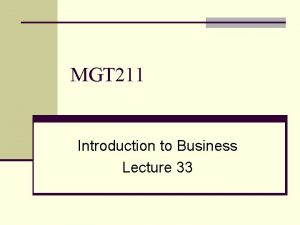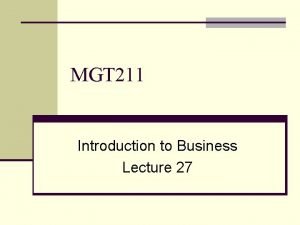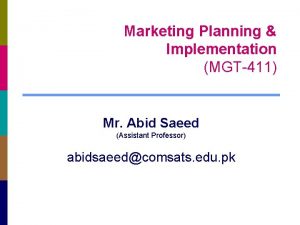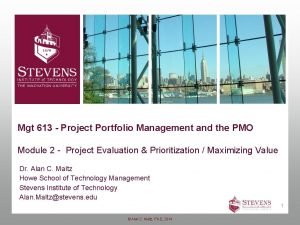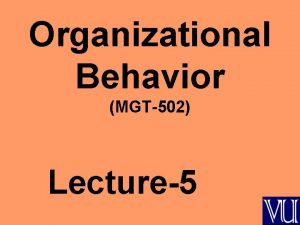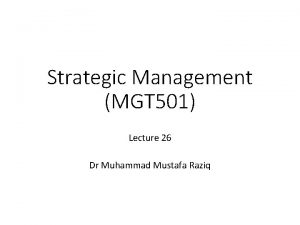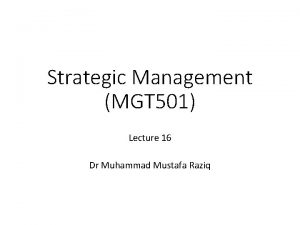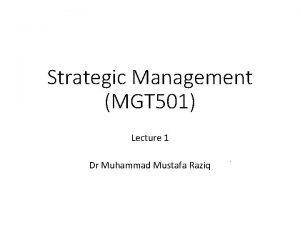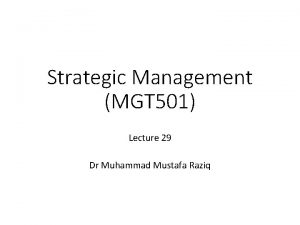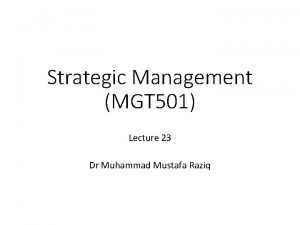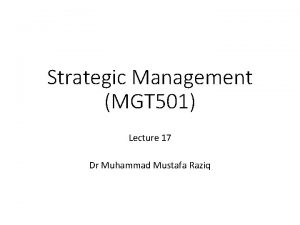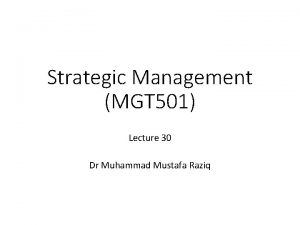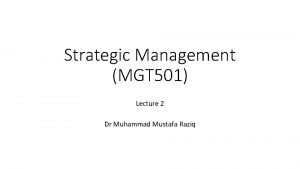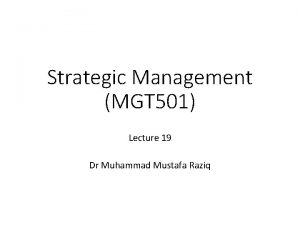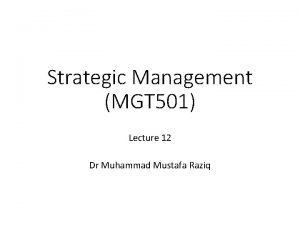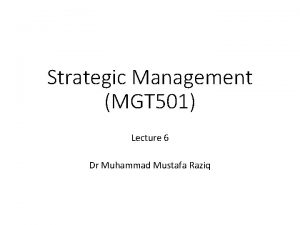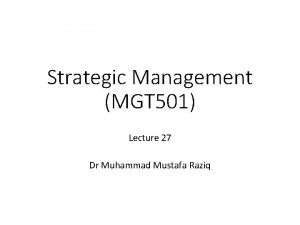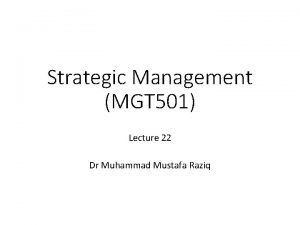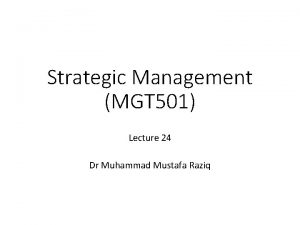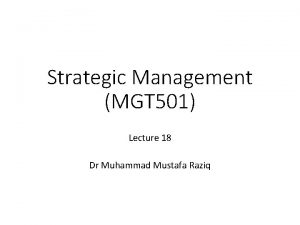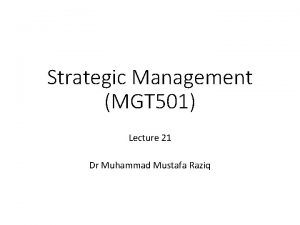Strategic Management MGT 501 Lecture 28 Dr Muhammad




















- Slides: 20

Strategic Management (MGT 501) Lecture 28 Dr Muhammad Mustafa Raziq

Topic Covered in the Previous Lecture • Marketing and Distribution Strategies • Production and Operations Management Strategies and Tactics

Topics to be covered in this lecture • R&D strategy or Innovation Strategy Creating Value Changing Processes • Learning Organization • Strategy Implementation Phase of the Strategic Management Process

7. 9. R&D Strategy or Innovation Strategy Creating Value Changing Processes • A firm’s performance improvement comes not only from innovation in its offerings but also from innovations in the management process. • Research and development function to conceive, design, develop prototype, test and package a product can be done in-house or can be outsourced to specialized R&D organizations • Product enhancements in existing products and developing new products are thus part of the R&D strategy • Management innovation is the new way of organizing, leading, coordinating, controlling, and motivating • Innovation in management principles and processes can create long lasting advantage and produce dramatic shifts in competitive position (Hamel, 2006)

7. 9. R&D Strategy or Innovation Strategy Creating Value Changing Processes (continued) • Hamel (2006) defines management innovation as a marked departure from traditional management principles, processes and practices or a departure from customary organizational forms that significantly alters the way the work of management is performed. • Any problem that is pervasive, persistent, or unprecedented is unlikely to be solved with the usual principles or practices of management. Some of notable management innovations are: • Knowledge management; brand management; cost accounting; strategic analysis; sustainability strategy; decentralization; divisionalization; project management; capital budgeting; ROI analysis etc

7. 9. 1. Innovation Strategy Roadmap • Anthony et al (2006) propose the following principles for building competitive advantage through innovation: • Pitch the playing field: before deciding how to play the innovation game, companies have to decide where to play, identify the market space the company wishes to target, and clarify what the company will not do • Build the growth playbook: by developing a checklist through analyzing 10 -15 major innovations in the market segment’s history. This checklist allows the firm to look at any opportunity from multiple perspectives, that is, customers, competitors, channel, and regulators. • Build the company’s game plan: create a short list of innovation ideas for the identified target market and to assess whether those ideas adhere to the general pattern of success and the checklist.

7. 9. 1. Innovation Strategy Roadmap (continued) • Anthony et al (2006) propose the following principles for building competitive advantage through innovation (continued): • Execute with Flexibility: with staged or phased investments, the new growth game plan is to be executed assessing the response. If the current strategy or innovation road map is not viable, then change the approach and revaluate or else move on to other projects. • Manage the innovation process: with novel-innovation based growth initiatives, right strategy is probably to be unknown and unknowable, and hence, the senior managers may adopt a problem solving approach rather than a stage gate approach.

7. 9. 2. Innovation Capability as a Sustainable Competitive Advantage • Akman and Yilmaz (2008) conceptualize innovation capability in a framework with proactiveness as the most important factor of innovation capability followed by analysis and futurity. • Venkataraman (1989) suggest the innovation capability as a set of competitive strategies, which are: • Aggressiveness: a combative posture in exploiting market opportunities • Analysis: ability to monitor and understand events and trends in the environment • Defensiveness: a firm need to defend its current position • Futurity: determining future changes with a wide variety of views and plans • Proactiveness: ability to recognize, anticipate, and act on opportunities • Riskiness: seeking and transforming market opportunities

7. 10. Learning Organization • With the changing environment the organization members need to learn continuously to update themselves about the technological advancements, demographic shifts, new legal structure, political trends, etc. • An organization where the members learn continuously and thereby transform the organization is called a learning organization. • A learning organization will be more innovative, competitive, and adaptive.

7. 10. 1. Knowledge Management • In an organizational life, its members gain experiences and insights while carrying out activities. These insights and experiences unique to situation are called knowledge that is embodied in individuals or embedded in processes or practices. • There are different types of knowledge in a organization such as tacit knowledge and explicit knowledge, content and relational knowledge, embedded knowledge and embodied knowledge, new knowledge (innovation), and established knowledge. • Knowledge helps in NPD, solving problems, and adaptive management. • Earlier, knowledge was managed through discussions, professional training, mentoring, and apprenticeship. Now the knowledge bases, expert systems, knowledge repositories, decision support systems, intranets, etc are used in knowledge management.

7. 10. 1. Knowledge Management (continued) • Knowledge management strategies for organizations include the following: • Push Strategy • Pull Strategy • Cross-project or inter-project learning • After action reviews • Knowledge mapping • Communities of practice • Best practice transfer • Knowledge fairs • Expert directories • Mentoring and apprenticeship • Social networking.

7. 10. 2. Competitive Advantage through Learning • In a learning organization, people continually expand their capability to create the results that they desire, where new and expansive patterns of thinking are nurtured, where collective aspiration is the set free, and where people are continually learning to see the whole together (Senge, 1990) • The learning in an organization needs to be correlated to the long term competitive advantages to term the learning strategic. For example the orientation to learn what is the maximum value potential or volume potential of a product by asking questions and finding answers to the following questions is probably to lead to competitive advantages (Next Slide).

7. 10. 2. Competitive Advantage through Learning (continued) • Questions: • Total consumers who consume the product • Total consumers who consume the substitutes • Total consumers who are aware of the product but not purchasing • Total consumers who can not afford the price • Total consumers who do not have the skill to use • Total consumers who oppose the product

Chapter 9: Strategy Execution

9. 1. Strategy Implementation Phase of the Strategic Management Process • If a firm wants to grow perpetually, the first step is taking a decision to apply the strategic management process • The initial steps in the strategic management process are to take a firm decision to change or to grow, which is followed by environmental monitoring and a performance audit for gap analysis. This is followed by a value scan to formulate the mission • The insights gained from environmental scan, value scan, resource audit, and gap analysis as part of the strategic analysis are likely to clarify intentions leading to strategic business modelling.

9. 1. 1. Implementation Models • There a diversity of strategic implementation models depending on the type of actors, contexts, and existing systems in organizations. An example on next slide.

9. 1. 1. Implementation Models (continued)

9. 1. 1. Implementation Models (continued) • Strategy is implemented by individuals and groups as actors in specific contexts, acting within organizational systems. • Implementation of strategy has six basic components: structural, functional, behavioral, procedural, project implementation, and resource allocation. • Strategy implementation starts with extending the strategic vision and strategic objectives throughout all units of the organization, encompassing every system to impact all operational processes needed to produce expected outputs. • A thorough assessment of the organization’s capacities in areas such as managerial capability, power structure, culture, leadership, governance structure, organizational structure, communication systems, and performance management systems at the strategic planning stage will help in effective implementation of the formulated strategy.

Summary of the topics covered in this lecture • R&D strategy or Innovation Strategy Creating Value Changing Processes • Learning Organization • Strategy Implementation Phase of the Strategic Management Process

Topics for the next lecture • Strategy Implementation Phase of the Strategic Management Process • Operationalizing Strategy: Translating Intention to Action • Implementing Strategic Change
 Mgt 501
Mgt 501 Mgt 501
Mgt 501 Mgt501 human resource management
Mgt501 human resource management Sabah translation
Sabah translation Attahiyat dua in english
Attahiyat dua in english Strategic management lecture
Strategic management lecture Resource based model
Resource based model Strategy analysis and choice largely involves making
Strategy analysis and choice largely involves making 01:640:244 lecture notes - lecture 15: plat, idah, farad
01:640:244 lecture notes - lecture 15: plat, idah, farad Mgt 323
Mgt 323 Define management accounting
Define management accounting Mgt 601
Mgt 601 Mgt 351 nsu course outline
Mgt 351 nsu course outline Mgt 340 assignment
Mgt 340 assignment Mgt321
Mgt321 Luyana211
Luyana211 Mgt 211
Mgt 211 Mgt 411
Mgt 411 Mgt 385
Mgt 385 Ecv expected commercial value
Ecv expected commercial value Mgt502 business communication
Mgt502 business communication
